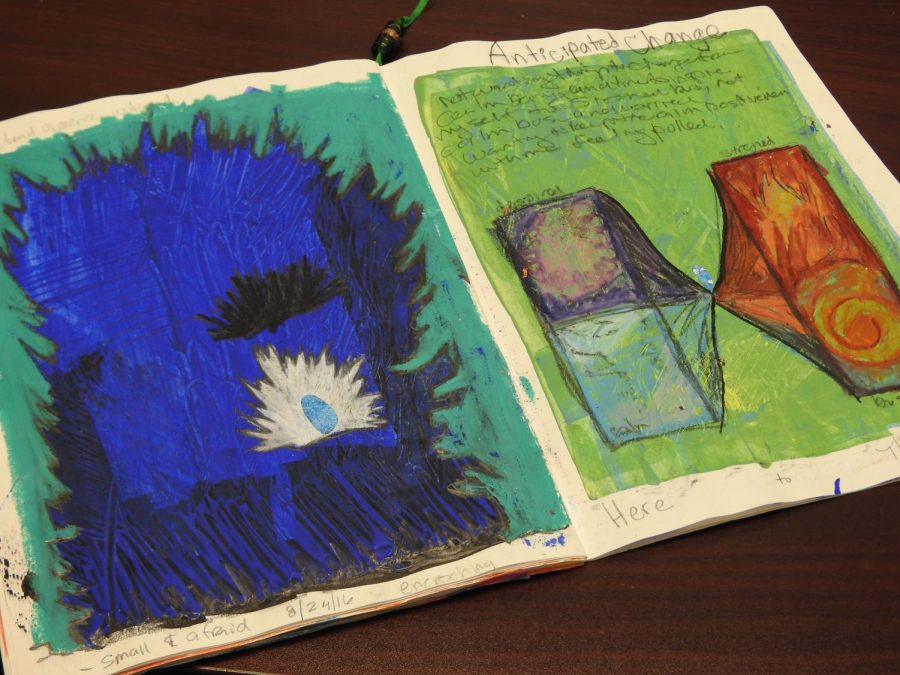Expression through painting: What is art therapy?
October 30, 2019
Christy Wolfram, an art therapist at NKU’s Health, Counseling and Student Wellness center, began her journey as an art therapist at a stranger’s house. This stranger, Don Jones, was a very sweet, short old man who walked with a cane, according to Wolfram. His studio was a large space above his garage decorated with all his self-portrait paintings.
“He focused on you in a way that made you feel like you were very important to him,” Wolfram said. “He didn’t tell me what my art meant but helped me to discover what it meant to me.”
Wolfram hadn’t heard of art therapy until her teacher suggested to shadow someone practicing it. But after drawing herself as a tree and participating in other art therapy directives, she gained new insights about herself through artwork and she began to have an interest in art therapy.
Wolfram shared that her own personal experience of using art to express and explore feelings and events in her life led her to art therapy, where she could help others.
Art therapy is a non-intrusive form of therapy that can be used to work through difficult feelings. Non-intrusive means that instead of diving into your emotions and trauma by going straight to talking about it, you allow it to come out into the art.
Art therapy must be done with a trained art therapist, or it cannot technically be called art therapy. Heather Conley, a former NKU student now getting her master’s in art therapy counseling at Southern Illinois University at Edwardsville, mentioned the importance of having a trained art therapist during a session.
“If you are not used to art therapy and you’re not schooled in it, you’re not going to be able to help [the client] when things come up because they can come up really fast with art therapy,” Conley said.
Art therapists are trained to see things in the artwork that other people may not see, but they cannot diagnose based off artwork. They still have to go through the regular therapeutic process to diagnose clients.
“The artwork is just a way in,” Conley said. “We are not fortune tellers.”
There is a tendency for people to doubt the legitimacy of art therapy, but art therapists are required to go through a very extensive training process and receive a high level of education before being able to practice.
“People don’t take the field of art therapy seriously,” Conley said. “They don’t think it’s legitimate and so we’re sort of fighting for recognition all the time.”
Lisa Jameson, NKU visual arts program head, said, “You can’t be an art therapist without a master’s degree.”
Jameson said that students studying to become art therapists have to focus on both psychology and studio arts, and that is only the beginning of their education. As a graduate student, they study not only art therapy, but counseling as a whole.
Conley talked about how she used to doubt the field of art therapy.
“At that time, like everybody else, I didn’t believe it was a real field, so I didn’t take it seriously,” Conley said.
Now, when Conley considers the legitimacy of art therapy, she thinks very differently. Conley thinks there is a lack of understanding that art therapists have the same training as traditional therapists.
“When you think of a therapist, you think of someone sitting on a couch doing talk therapy. We are trained to do that exact same thing,” Conley said. “We go through all the same training that a regular therapist would go through, but we have the additional training of expressive therapy.”
Art therapy focuses on the process of the client’s art making, not on the product. There is a particular emphasis on the idea that you do not need to have experience or skill in art making to participate in art therapy.
A common challenge for people engaging in art therapy is having negative thoughts about their ability. Most people stop drawing in middle school and when they’re asked to do art for therapy, it can be frustrating because their skill level is at the middle school level.
“People sometimes say, ‘I can’t draw’ … and that can be a challenge,” Wolfram said. “You do not have to have any art experience or be, quote unquote, ‘good’ at art to participate in art therapy.”
Despite these challenges, art therapy can be extremely beneficial in working through stress, trauma or overwhelming feelings and emotions.
“It allows people a different way to express that isn’t necessarily them having to speak, because a lot of times people are feeling things that they can’t put words to,” Conley said.
Wolfram also said that art therapy is a good option for people who are trying to work through things that are difficult to talk about.
“It helps externalize some feelings to get them down onto the page, and that can be easier to talk about—the drawing instead of the stress or trauma,” Conley said.
NKU has some simple opportunities to get involved with art therapy for faculty and students. Next semester, Wolfram will be starting an art therapy group called “Destress with Art” that will be meeting weekly. The meetings are expected to be held on Wednesday afternoons.
To join this group, reach out to the Health, Counseling and Student Wellness center to schedule a free group brief screening with Wolfram. During this process, she will ask those in the brief screen why they want to join the group and what their goals are, as well as what to expect.
Another way to get involved with art therapy will be on November 18, at 12:00 p.m. in the University Center. Wolfram will be having a free vision board workshop, using magazine collage pictures, and attendees will set goals for your future.

